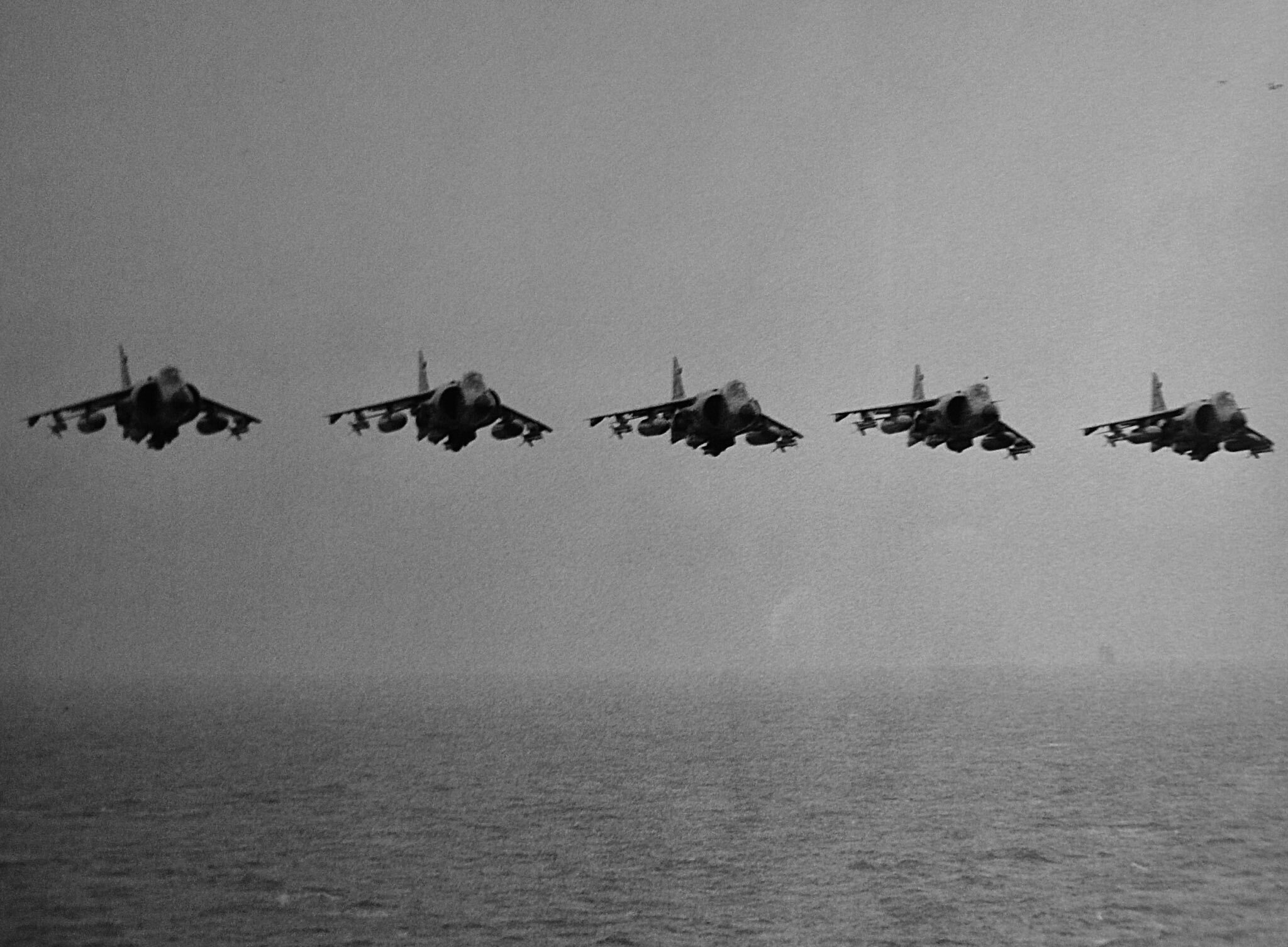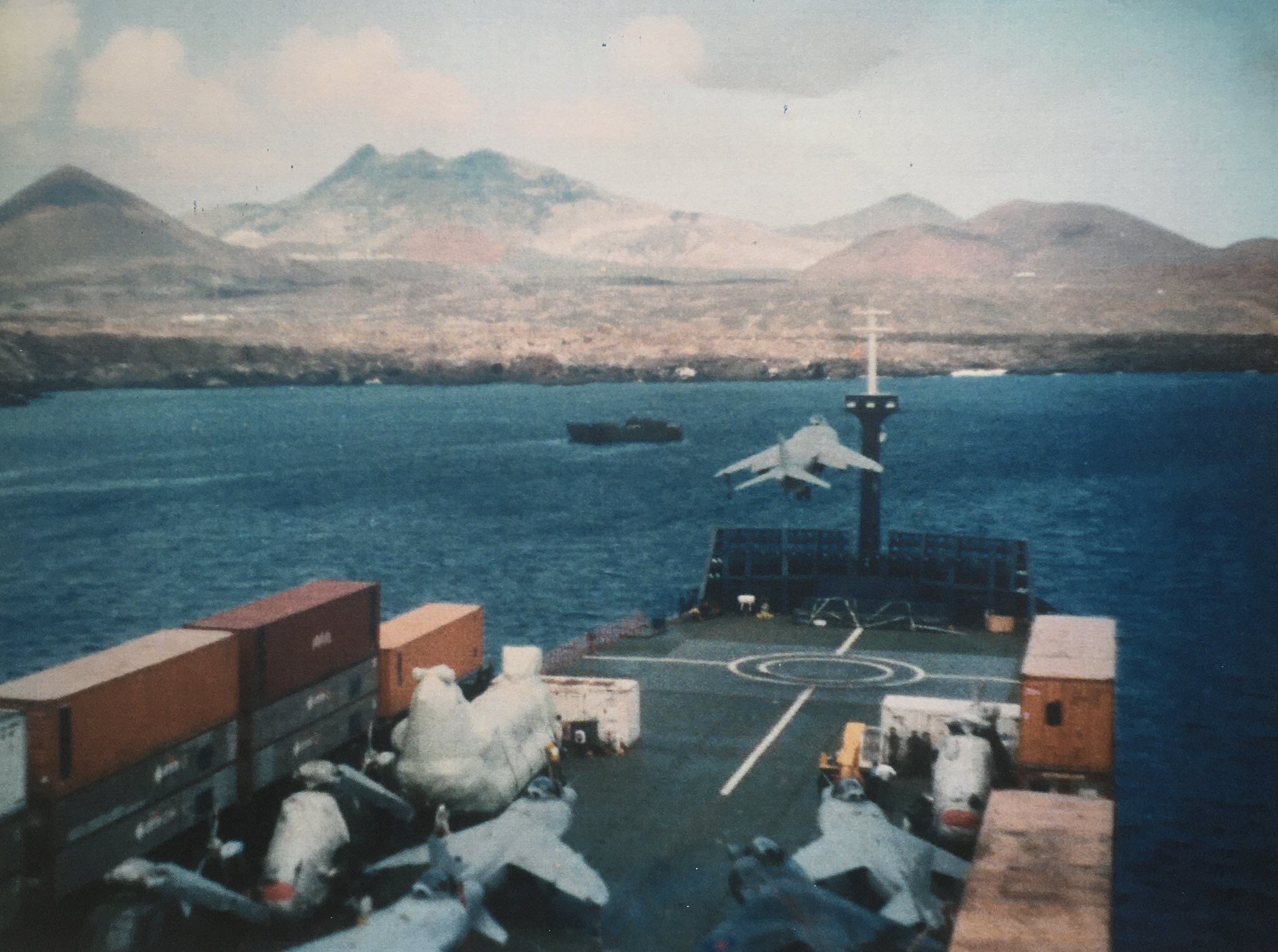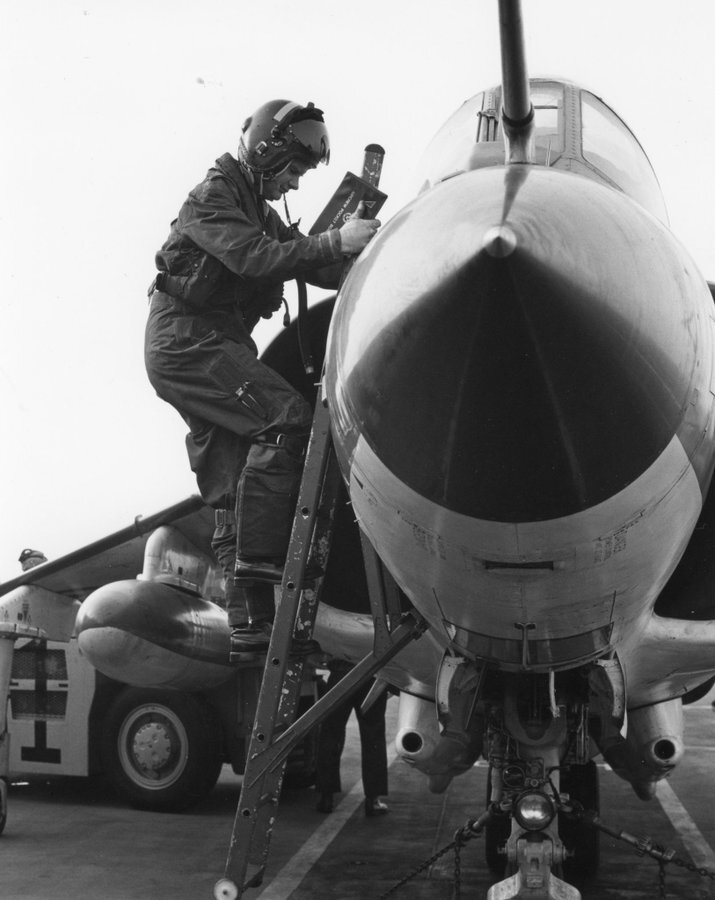
The story of the Falklands War has quickly become a part of the British mythos. A hastily thrown together Task Force, with two small carriers and twenty even smaller fighters taking on the might of the Argentine Air Force and Navy. It was a close-run thing. In Rowland White’s latest book Harrier 809, he returns to two of his previous subjects, the Falklands War and 809 Naval Air Squadron, and shows us that things really were, at times, upon a wing and a prayer.
Harrier 809 opens with rookie Sea Harrier, or in Navy slang SHAR, pilot Lieutenant Simon Hargreaves strapping himself in and blasting off from HMS Hermes to intercept an Argentine Boeing 707 reconnaissance flight. As Hargreaves races to 40,000’ to intercept the Boeing, it dawns on him he may have to kill. The two belligerents have met and the shooting will start soon. Hargreaves had only been out of training for two months.
White’s opening is a carefully managed juggling act. Having covered the incredible urgency of the Task Force’s departure in that spring of 1982 in greater detail in his sublime Vulcan 607, White chooses to focus on his new cast of characters. We are introduced to Lieutenant Commander Tim Gedge who is in the middle of a lecture on the upcoming Naval Redundancy programme. War really never comes when one expects it and if you wrote that in a film script, no one would buy it. With the Fleet Arm Arm’s two squadrons of Sea Harriers, 800 and 801 Naval Air Squadrons (NAS), deployed upon HMS Hermes and Invincible respectively, Tim Gedge was ordered to a now-empty RNAS Yeovilton to resurrect a phoenix. 809 NAS was to be reborn, from scratch, just as quickly as he could. There was a couple of hitches though, 809 didn’t have a ship to deploy onto, let alone any Sea Harriers to actually fly.

A flock of Sea Harriers. Image: Rowland White
The ‘men on a mission’ passage that follows, as pilots are called in from all over the world, was clearly great fun to write and is utterly brilliant to read. White skillfully explains how Gedge brings the new squadron together, while, at sea, Andy Auld and Nigel ‘Sharkey’ Ward get their men and machines onto a war footing as the Task Force steams south. It is a delicate balancing act. White has to introduce many new faces to the tale, get you up to speed on the many (oh so many) Naval acronyms that you will need to know for the next few hundred pages, introduce the Sea Harrier herself properly, explain why there was a question mark over it and take you through how a Sidewinder Infrared AIM-9 missile works, including while the Nine-Lima was preferable to the Nine-Kilo. He manages this with aplomb and in the same engaging style that has made his previous books so readable. A key element in Harrier 809 is the men and machines that would be in the SHAR’s gun sights and vice versa, the Argentine crews and their aircraft.

An Argentine Super Etendard
The Argentine viewpoint of the air conflict above Las Malvinas is one of the highlights of Harrier 809. Having walked past the many portraits of the fallen in the entrance hall of the Edificio Cóndor in Buenos Aires, getting to meet some of the men in those paintings was enlightening and humbling. White treats these pilots with the same respect as he does the Fleet Air Arm and RAF pilots steaming south to meet them. In what could have been nothing more than a description of the menacing Exorcet missile and the types of foe the Task Force would be facing. The many similarities between the two sides are laid bare, the speed at which they needed to deploy, the crippling budgetary issues in the lead up to the war leaving them rather thin on the ground and the professionalism of the men who would fight and die above the freezing South Atlantic.

809 Naval Air Squadron’s Sea Harriers abroad Atlantic Conveyor, off Ascension Island in 1982. Image: Rowland White
Harrier 809 could easily have been a very gung-ho romp of Harriers in action. The underdog, underrated aircraft and her crews going up against the odds and succeeding. But White turns the story into an incredibly balanced look at a very close run conflict. While it becomes clear the Islands would be retaken, the cost calculations that go on in Sandy Woodward’s mind, those faced by many before him, are stark. Witnessing the Argentines as they took off and headed east, knowing what they are going up against and their determination to see it through is vividly conveyed. All the while, White creates the growing sense of dread as a converted container ship, under the command of the wonderful Ian North, heads south with 809 NAS and the Task Force’s helicopters into the eye of a very modern storm. White balances this all and does justice to each thread he unravels.

- Lt Cdr Tim Gedge climbing down from his SHAR abroad HMS Hermes in 1981. Image: Rowland White
Rowland White writes with an enviable verve that draws you in. White’s examination of the leadership skills Tim Gedge deployed in spinning up 809 NAS in a matter of weeks is one that transcends the tale. Those of us who form and lead teams can take a lot from Gedge’s example and we should look to see how we can emulate him in our own small way. Throughout Harrier 809, the changes of perspective are handled sensitively, each loss, on each side, carries weight. The result is that Harrier 809 is White at the peak of his powers.
Harrier 809 is an incredible tale, deftly told and leaves you wanting more. Thankfully, White leaves us with a ‘Post-credit Sting’ that would make the Marvel people green with envy. The story does not quite end at sea.
Harrier 809 by Rowland White is released on 15 October 2020 and is published by Bantam Press who kindly provided this review copy. If you would like a copy of Harrier 809 might I suggest using the Bookshop.org link below? By using that link, 10% of each sale will go to supporting The Damcasters.

This story about 809 is not factually correct, because 809 on Atlantic Conveyor was effectively disbanded, the eight aircraft became part of the two front line squadrons, four to 800 HMS Hermes and four to 801 HMS Invincible, hence forth from the 18th May 1982, there was no 809 Sqdn.
I believe Tim Gedge became part of 801 on HMS Invincible. The aircraft had there markings changed to reflect they were now part of 800 and 801.
809 did not exist again until they came down on HMS Illustrious and relieved HMS Invincible on the 28th August 1982.
Hello Philip,
Thanks for reading the review and leaving your comment. I’d recommend reading Harrier 809 as this is made more clear in the book. The fact of the matter is that 809 NAS was successfully spun up and deployed at all to be able to join 800 and 801 NAS is one of the most remarkable of the war. Tim Gedge’s leadership and man-management is one that needs to be celebrated. I hope you enjoy the book, my review was only meant to highlight aspects of it and not spoil it for reads.
Best regards, Matt